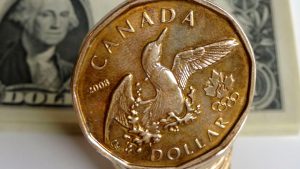 Friday’s trade (in GMT terms) saw USD/CAD within the range of 1.2831-1.3013. The pair closed at 1.3005, rising 0.64% compared to Thursdays close. It has been the 171st gain in the past 325 trading days and also the sharpest one since August 19th. The daily high has been a level unseen since August 11th, when a high of 1.3081 was registered. In weekly terms, USD/CAD added 1.04% to its value during the past week. It has been the 12th gain in the past 34 weeks. The major pair has pared its slump to 0.18% so far during the current month, following a 0.80% gain in July.
Friday’s trade (in GMT terms) saw USD/CAD within the range of 1.2831-1.3013. The pair closed at 1.3005, rising 0.64% compared to Thursdays close. It has been the 171st gain in the past 325 trading days and also the sharpest one since August 19th. The daily high has been a level unseen since August 11th, when a high of 1.3081 was registered. In weekly terms, USD/CAD added 1.04% to its value during the past week. It has been the 12th gain in the past 34 weeks. The major pair has pared its slump to 0.18% so far during the current month, following a 0.80% gain in July.
At 8:22 GMT today USD/CAD was inching up 0.02% on the day to trade at 1.3007. The pair touched a daily high at 1.3026 during early Asian trade, overshooting the daily R1 level, and a daily low at 1.2988 during the late phase of the Asian trading session.
Meanwhile, crude oil futures marked their 85th gain out of the past 180 trading days on August 26th. Oil for October delivery went up as high as $48.46 per barrel, or its highest price level since August 22nd, and closed at $47.64, advancing 0.65% compared to Thursday’s close. As of 8:19 GMT today the commodity was losing 1.57% to trade at $46.89, after going down as low as $46.78 per barrel earlier. Crude oil prices and CAD valuation tend to be strongly positively correlated.
On Monday USD/CAD trading may be influenced by the following macroeconomic report listed below.
Fundamentals
United States
Personal Income, Personal Spending and PCE Inflation
Personal spending in the United States probably rose 0.3% in July, according to market expectations, while personal income was probably up for a 16th consecutive month in July, increasing at a monthly rate of 0.4%.
Consumer spending, which accounts for over two thirds of the nation’s GDP, rose 0.4% in June, while matching the rate in May. In June, spending on non-durable goods increased 0.7%, spending on services rose 0.5%, while spending on long-lasting manufactured goods such as automobiles shrank 0.3%.
At the same time, personal income increased 0.2% in June, following another 0.2% surge in the prior month. In June, wages and salaries went up 0.3%, proprietors income rose 0.6%, while rental income increased 0.4%. On the other hand, personal dividend income went down 0.7% and personal interest income was 0.3% lower.
Higher-than-expected rates of increase imply good employment conditions and, therefore, are dollar positive. The Bureau of Economic Analysis is to publish the official figures at 12:30 GMT.
At the same time, the Core PCE Price Index, the preferred measure of inflation by the Federal Reserve, probably rose 1.6% year-on-year in July, according to expectations, or matching the rate of increase reported in the previous four months. On a monthly basis, the Core PCE Price Index probably increased for a seventh consecutive month in July, going up 0.1%, according to analyst projections.
Correlation with other Majors
Taking into account the business week ended on August 26th and the daily closing levels of the major currency pairs, we come to the following conclusions in regard to the strength of relationship:
USD/CAD to USD/JPY (0.9344, or very strong)
USD/CAD to USD/CHF (0.8389, or very strong)
USD/CAD to GBP/USD (-0.7216, or strong)
USD/CAD to EUR/USD (-0.7949, or strong)
USD/CAD to AUD/USD (-0.8757, or very strong)
USD/CAD to NZD/USD (-0.9157, or very strong)
1. During the examined period USD/CAD moved strongly in the opposite direction compared to GBP/USD and EUR/USD.
2. USD/CAD moved almost equally in one and the same direction with USD/CHF and USD/JPY during the past week. This relationship has been the most pronounced between USD/CAD and USD/JPY.
3. USD/CAD moved almost equally in the opposite direction compared to AUD/USD and NZD/USD during the period in question. This relationship has been the most pronounced between USD/CAD and NZD/USD.
Bond Yield Spread
The yield on Canada’s 2-year government bonds went as high as 0.610% on August 26th, or the highest level since July 29th (0.611%), after which it closed at 0.607% to add 1.5 basis points (0.015 percentage point) compared to August 25th.
Meanwhile, the yield on US 2-year government bonds climbed as high as 0.849% on August 26th, or the highest level since June 3rd (0.899%), after which it fell to 0.845% at the close to add 5.2 basis points (0.052 percentage point) compared to August 25th.
The spread between 2-year US and 2-year Canadian bond yields, which reflects the flow of funds in a short term, widened to 0.238% on August 26th from 0.201% on August 25th. The August 26th yield spread has been the largest one since June 9th, when the difference was 0.251%.
Daily, Weekly and Monthly Pivot Levels
By employing the Camarilla calculation method, the daily levels of importance for USD/CAD are presented as follows:
R1 – 1.3022
R2 – 1.3038
R3 (Range Resistance – Sell) – 1.3055
R4 (Long Breakout) – 1.3105
R5 (Breakout Target 1) – 1.3164
R6 (Breakout Target 2) – 1.3189
S1 – 1.2988
S2 – 1.2972
S3 (Range Support – Buy) – 1.2955
S4 (Short Breakout) – 1.2905
S5 (Breakout Target 1) – 1.2846
S6 (Breakout Target 2) – 1.2821
By using the traditional method of calculation, the weekly levels of importance for USD/CAD are presented as follows:
Central Pivot Point – 1.2950
R1 – 1.3068
R2 – 1.3132
R3 – 1.3250
R4 – 1.3369
S1 – 1.2886
S2 – 1.2768
S3 – 1.2704
S4 – 1.2641
In monthly terms, for USD/CAD we have the following pivots:
Central Pivot Point – 1.3038
R1 – 1.3244
R2 – 1.3460
R3 – 1.3666
R4 – 1.3872
S1 – 1.2822
S2 – 1.2616
S3 – 1.2400
S4 – 1.2184





